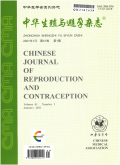促性腺激素释放激素拮抗剂方案与超短方案对卵巢储备功能低下患者行体外受精-胚胎移植妊娠结局的影响
Effects of gonadotropin-releasing hormone antagonist protocol and gonadotropin-releasing hormone agonist short protocol on diminished ovarian reserve patients
摘要目的:评价促性腺激素释放激素(GnRH)拮抗剂方案在卵巢储备功能低下(diminished ovarian reserve,DOR)患者行体外受精-胚胎移植( in vitrofertilization-embryo transfer,IVF-ET)中的应用效果。 方法:回顾性队列研究分析2015 年1月至2016年12月期间在西北妇女儿童医院生殖中心首次接受IVF-ET治疗的DOR患者的临床资料,根据促排卵方案不同,分为GnRH拮抗剂方案组和超短方案组。比较两组一般情况、临床及实验室指标、妊娠结局。结果:活产率、临床妊娠率、种植率组间比较差异均无统计学意义( P>0.05)。GnRH拮抗剂方案组Gn用量[(3 082.04±1 004.40) IU]比超短方案组少[(3 510.05±1 119.09) IU]( P<0.001),Gn使用时间[(9.66±2.13) d]比超短方案组短[(10.63±2.27) d, P<0.001],获卵数(4.54±2.97)比超短方案组少(5.54±3.54, P<0.001)。 结论:DOR患者采用GnRH拮抗剂方案超促排卵治疗与超短方案妊娠结局相似,且Gn用量更少、Gn使用时间更短。因此,GnRH拮抗剂方案也是DOR患者适宜的促排卵方案之一。
更多相关知识
abstractsObjective:To evaluate the effect of gonadotropin-releasing hormone antagonist (GnRH-A) protocol on in vitro fertilization-embryo transfer (IVF-ET) in patients with diminished ovarian reserve (DOR). Methods:A retrospective cohort study was performed to analyze the clinical data of the DOR patients who received IVF-ET treatment for the first time at the Northwest Women's and Children's Hospital Reproductive Center during January 2015 to December 2016. They were divided into a GnRH-A protocol group and an gonadotropin-releasing hormone agonist (GnRH-a) short protocol group according to different ovulation induction protocols. The general conditions, clinical and laboratory indicators, and pregnancy outcomes of the two groups were compared.Results:There was no statistically significant difference in live birth rate, clinical pregnancy rate and implantation rate between the two groups ( P>0.05). The dosage of gonadotropin (Gn) used in GnRH-A protocol group [(3 082.04±1 004.40) IU] was less than that in GnRH-a short protocol group [(3 510.05±1 119.09) IU], P<0.001], the duration of Gn used [(9.66±2.13) d] was shorter than that in GnRH-a short protocol group [(10.63±2.27) d, P<0.001], the number of eggs (4.54±2.97) was less than that in GnRH-a short protocol group (5.54±3.54, P<0.001). Conclusion:DOR patients using GnRH-A protocol for hyperovulation therapy have similar outcomes to GnRH-a short protocol pregnancy, with less Gn used dosage and shorter Gn used duration. Therefore, the GnRH-A protocol is also one of the suitable ovulation induction for DOR patients.
More相关知识
- 浏览0
- 被引7
- 下载0


相似文献
- 中文期刊
- 外文期刊
- 学位论文
- 会议论文



 换一批
换一批 换一批
换一批



